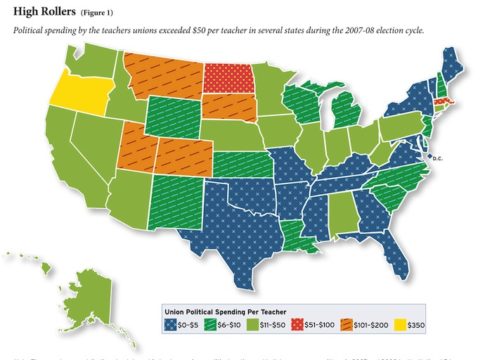The National Education Association (and its local affiliates) gave $56.3 million dollars to state and federal election campaigns in 2007 and 2008, more than any other entity. That’s what we learn from the recently released report issued by the Center for Responsive Politics (CRP) together with the National Institute on Money in State Politics.
The much smaller American Federation of Teachers tossed in another $12 million dollars into political campaigns.
In second, third and fourth place on the CRP list, at $43.4, $40.4. and $38.5 million dollars, respectively, are the Pechanga Band of Luiseno Mission Indians, Penn National Gaming, and Morongo Band of Mission Indians, facts that probably explain just why state-approved casino gambling has been spreading its dirty business so far and wide that “gaming” operators in Atlantic City and Las Vegas are toying with bankruptcy.
The NEA’s vast political fund is even more nefarious. The money is wrested directly from teacher paychecks as an add-on to their monthly dues (unless teachers specifically object), a power granted unions by school boards as part of collective bargaining deals. So the NEA’s slush fund is in fact built by taxpayer dollars, which flow directly to the NEA instead of into the teacher’s own bank account. Yes, some individual teachers object and don’t make the political contribution, but unions typically collect the money by default.
With all that cash in hand, unions are in a position to tell state legislatures what to do, if they want campaign dollars next time around. Significantly, over $53 million of the $56.3 million dollars went for state-level expenditures, a clear indication that unions know that the action is not in Washington but in state capitols.
This enormous cash nexus that swamps anything any business entity has contributed creates a huge problem for President Obama’s Secretary of Education, Arne Duncan, who is asking states and school districts to put merit pay into place. Teacher unions don’t like that idea for the very simple reason that union solidarity requires that every teacher be paid the same amount (save for experience and credentials). And unions don’t like dismissing ineffective teachers for the very simple reason that union power rests on union commitment and capacity to defend every teacher from losing his or her job.
So is reform of the teaching profession possible? Can the system of recruiting and compensating teachers be transformed from the industrial model to the professional model needed for human capital growth in the 21st Century? That is the $68.3 ($56.3 plus $12) million dollar question.
Hat Tip: Education Intelligence Agency



